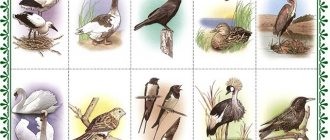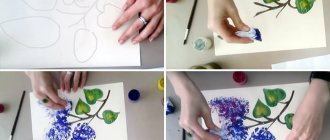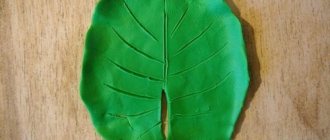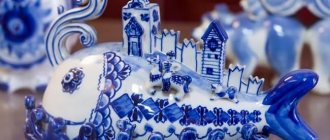Integration of educational areas: “Cognition”, “Communication”, “Socialization”, “Reading fiction”, “Music”, “Health”, “Physical education”. Types of children's activities: gaming, cognitive, communicative, motor, musical and artistic.
GCD goals
1. Educational aspect: Educational area “Cognition”: - Systematize children’s knowledge about geometric shapes (circle, square and triangle), color, size of an object. -Avoke a desire, with the help of the teacher, to stage and dramatize short passages from folk tales. Educational area "Music": -Promote the development of musical imagination. Educational area “Communication”: -Promote the development of all components of children’s oral speech, free communication with adults and children. 2. Developmental aspect: -Promote the development of children's creativity in the process of productive activity. -Ensure the development of the ability to generalize and draw conclusions. 3. Educational aspect: Educational area “Socialization” - Form social skills. - Create a desire to help the heroes of the fairy tale. -To promote the development of the ability to follow basic rules during the game. 6. Educational area “Health”: -Promote the preservation of children’s health through the use of health-saving technologies. — Systematize children’s knowledge about the benefits of this product. Educational area “Reading fiction”: -Arouse children’s interest in fiction. 7. Educational area “Physical education”: -Ensure optimal motor activity of children during educational activities. Methods and techniques. 1. Visual: (showing, demonstration) 2. Verbal: artistic expression, conversation, story, questions, explanations. 3. Playful: surprise moment, d/i, dramatization. Preliminary work. 1. Joint activity: Free communication on the fairy tale “Turnip”, conversation about the heroes of the fairy tale. Examination of paintings depicting characters from the fairy tale. Guessing riddles. Applique and sculpting of a “turnip”. 2. Educational activities during restricted periods: Didactic games for the development of mathematical abilities. Cut-out pictures and puzzles based on the fairy tale “Turnip”. Outdoor games. 3.Children’s independent activities: looking at illustrations based on fairy tales, table theater. Drawing and sculpting fairy tale characters. Dramatization games with costume elements (caps) and attributes as external symbols of the role. Vocabulary work: enriching the dictionary with words (patch, geometric shapes, vitamins). Form of implementation: Game-travel. Modern technologies used: health-saving, socio-game elements, personality-oriented. The course of direct educational activities. The teacher and children stand in a circle. The ritual began with NOD V. (together with the children) “Stand up, children, stand in a circle, You are my friend and I am your friend, We will hold hands tightly, And we will smile at each other.” Q. Children, do you want to go on a fairytale journey? (children’s answer) I have a magical “flying carpet”, on which we will go on our journey. (the teacher unrolls the “flying carpet”, and there are holes in the form of geometric shapes.) Q. Guys, look, our carpet is full of holes. Who could have done this? (children answer). But it seems to me that this was done by the one about whom I will now read a riddle: “Small stature, long tail, gray coat, sharp teeth (Mouse).” Q. That’s right guys, it was a mouse that gnawed through our “flying carpet!” And in order for us to go on a trip, we need to repair it. (D/I “Find the patch”). (There are geometric shapes on the tray, the children put them on and identify those “patches” that are suitable for repairing the carpet.) Q. Children, what geometric shapes did we need? What color and size are they? (children's answers) V. Well done, kids, you completed this task, the carpet was repaired, now we can go on our trip on the “magic carpet”. We stand on the carpet and repeat these magical words with me. Our carpet is rushing across the sky, What will happen to us? Close your eyes quickly to find yourself in a fairy tale. (The phonogram turns on, and the children find themselves in a fairy tale.) Q. We ended up in a fairy tale, but guess which one. Round side, yellow side A bun is sitting in a bed. He was rooted firmly into the ground. What is this? (turnip). (children's answers) V. Well done, you guessed the riddle correctly. Look what a beautiful turnip we have! Children, let's now remember the fairy tale. (Children begin to remember the fairy tale, laying out the figures of the heroes of the fairy tale in a certain sequence.) V. Grandfather planted a turnip, and the turnip grew big and big. Grandfather began to pull the turnip, he pulled, he pulled, but he couldn’t pull it out. He began to call Grandma. Q. What did your grandfather call your grandmother? (Children call grandma) Grandma……….. help me pull out the turnip. Grandma came running. (A figurine of a grandmother is placed on the table). The teacher together with the children says: “Grandma for Dedka, Dedka for Turnip, they pull, they pull, they can’t pull. Q. Who did Grandma call? (Granddaughter) What did Grandma call her Granddaughter? (children call) -Granddaughter......help me pull out the turnip! V. Granddaughter came running. Granddaughter for Grandmother, Grandmother for Grandfather, Grandfather for Turnip, they pull, pull, but cannot pull it out. V. The granddaughter began to call Zhuchka for help. Call me, what did Granddaughter call Zhuchka? (children call) - Bug………… help us pull the turnip! B. “Complete my task, then I’ll help.” Children, let’s help complete the Bug’s task. D/I “Arrange the Christmas trees” (children sit at the tables) Q. You need to arrange the Christmas trees, from the highest to the lowest (we lay them out with your right hand, from left to right.) Q. Which tree is this, and this one, and this one…..? Well done children, you completed Zhuchkin’s task! (The Bug figurine is placed on the table). Q. Bug started calling who? A cat. Let's all call the Cat together! (children call) V. And the Cat says: “To pull out a turnip, you need to do exercises!” Physical education minute. So we planted a turnip (bend over) and watered it with water. (Imitation of movement) Now let’s pull it, (imitation of movement) And we’ll cook porridge from the turnip, (imitation of movement) And we will be from the turnip, healthy and strong, (show strength) V. Thank you, guys. I'll go help you pull the turnip. V. They pull, they pull, they cannot pull. The Cat began to call the Mouse. And the Mouse says: “Complete drawing short mustaches and long tails for my mouse friends, then I’ll help.” (Children come to the tables and complete individual tasks.) Q. Well done, guys, for helping my friends! The Mouse began to pull the turnip, they pulled, they pulled, and they pulled out the turnip! Guys, turnips are a very tasty and healthy product. It contains a lot of vitamins. It gives people strength and health. That's the end of the fairy tale! It's time for us to return home to kindergarten. (children sit on the “airplane carpet” and say words) Our carpet is racing across the sky, so that we can return home. (A phonogram sounds) Summary of the lesson. V. (asks the children questions) - what fairy tale did we visit? — what heroes did you see? — how did we help them? Conclusion. Q. Children should always help each other. And then everything will work out! End of class ritual. Let's hold hands tightly, And we'll smile at each other, And we'll give each other a kiss goodbye! Self-analysis of direct educational activities Integration of educational areas: “Cognition”, “Communication”, “Socialization”, “Reading fiction”, “Music”, “Health”, “Physical education”. Types of children's activities: gaming, cognitive, communicative, motor, musical and artistic. GCD goals: 1. Educational aspect: Educational area “Cognition”: - Systematize children’s knowledge about geometric shapes (circle, square and triangle), color, size of an object. -Avoke a desire, with the help of the teacher, to stage and dramatize short passages from folk tales. Educational area "Music": -Promote the development of musical imagination. Educational area “Communication”: -Promote the development of all components of children’s oral speech, free communication with adults and children. 2. Developmental aspect: -Promote the development of children's creativity in the process of productive activity. -Ensure the development of the ability to generalize and draw conclusions. 3. Educational aspect: Educational area “Socialization” - Form social skills. - Create a desire to help the heroes of the fairy tale. -To promote the development of the ability to follow basic rules during the game. 4. Educational area “Health”: -Promote the preservation of children’s health through the use of health-saving technologies. — Systematize children’s knowledge about the benefits of this product. Educational area “Reading fiction”: -Arouse children’s interest in fiction. 5. Educational area “Physical education”: -Ensure optimal motor activity of children during educational activities. Methods and techniques. 1. Visual: (showing, demonstration) 2. Verbal: artistic expression, conversation, story, questions, explanations. 3. Playful: surprise moment, d/i, dramatization. Preliminary work. 1. Joint activity: Free communication on the fairy tale “Turnip”, conversation about the heroes of the fairy tale. Examination of paintings depicting characters from the fairy tale. Guessing riddles. Applique and sculpting of a “turnip”. 2. Educational activities during restricted periods: Didactic games for the development of mathematical abilities. Cut-out pictures and puzzles based on the fairy tale “Turnip”. Outdoor games. 3.Children’s independent activities: looking at illustrations based on fairy tales, table theater. Drawing and sculpting fairy tale characters. Dramatization games with costume elements (caps) and attributes as external symbols of the role. Vocabulary work: enriching the dictionary with words (patch, geometric shapes, vitamins). Form of implementation: Game-travel. Modern technologies used: health-saving, socio-game elements, personality-oriented. Teaching aids: Equipment for GCD, didactic games. The full development of a preschool child should be carried out in activities that are interesting and meaningful to him, which was taken into account by me when organizing and conducting this direct educational activity. Children were involved in playful and mental activities. When planning direct educational activities, the principle of integration of educational areas was taken into account. The educational process during direct educational activities was built on the basis of a person-oriented model of interactions with children, using health-saving and socio-game technology. At the same time, I took into account one of the main positions of the teacher and children as equal partners included in the common joint activity. The use of these technologies made it possible to avoid physical and emotional overload of pupils, to create conditions for the manifestation of individuality, the development of communication skills, the ability to express themselves, and satisfy the need for motor activity of a preschooler. Learning takes place in a playful way, using games that develop attention, cognitive processes, form social communication skills, and activate the physical strength and mental activity of children. The type of GCD carried out is integrated. This made it possible to avoid overstraining children during classes, by switching to a variety of activities, and to increase children’s cognitive interest. When constructing the GCD, I took into account the requirements for the structure of the integrated GCD: clarity, compactness of educational material, logical interconnection of the parts of the GCD; information capacity of the educational material used in the lesson. The educational activity itself consists of three parts: introductory main and final. The purpose of the introductory part was to create a favorable psychological mood in children, concentrating their attention on joint activities. To do this, I used the game “Stand up, children, stand in a circle.” A surprise moment with the use of a fabulous “airplane carpet” helped to motivate children to implement the assigned tasks, to arouse their cognitive interest in the upcoming activity. The children were interested in getting into the fairy tale. And the riddles helped the children find out what fairy tale they were in. Using patches, we were able to repair the carpet, while fixing the name of the geometric shapes and their color. The main part of the direct educational activities was aimed at awakening children's interest in theatrical acting, conveying the emotional state of a person (facial expressions, gestures, movements). Strengthening the ability to highlight color, shape, size. All parts of the direct educational activity are closely interconnected with each other, united by one plot, which helped maintain the interest of children throughout the entire lesson. I gave each child the opportunity to participate in the lesson. I strived to ensure that each child had a result that would indicate his progress, showing what he had learned. The forms of organization of children in direct educational activities were varied. These are social games in a circle, frontal work. The physical exercise “Here we planted a turnip.....” contributed to consolidating the ability to reproduce movements according to the text and relieving static tension through physical exercises. The dramatization of the fairy tale “Turnip” helped bring the children to the conclusion that only everyone together can cope with any task. And we always need to help each other. Didactic games: “Patch”, “Arrange Christmas trees”, “Draw a tail and mustache for the mouse” systematized children’s knowledge about geometric shapes (circle, square, triangle), color, and size of an object. Final part. The ritual of ending the educational activity helped relieve children's excitability and tension, and increased positive emotions associated with direct educational activities. The duration of the GCD is maintained in accordance with sanitary norms and rules, as well as the age characteristics of children of this age. The program material was selected in accordance with the FGT. Thus, we can conclude that the assigned tasks have been fully implemented.



